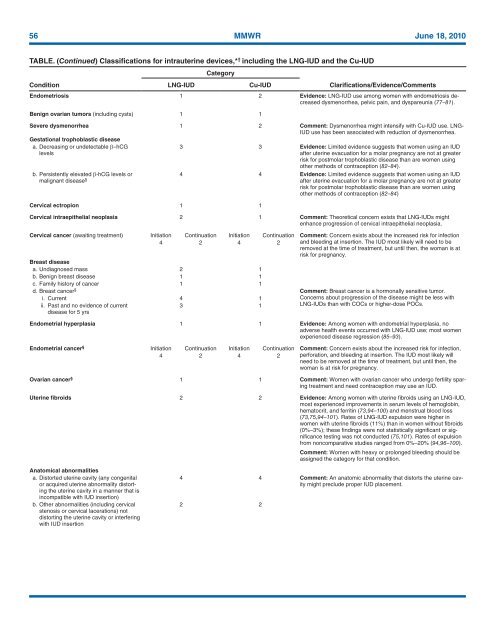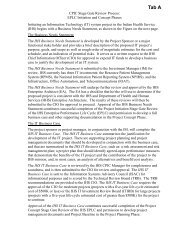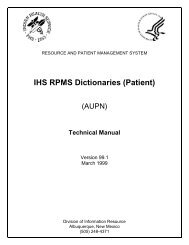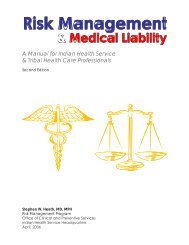CDC Article-US Medical Eligibility Criteria for Contraceptive Use, 2010
CDC Article-US Medical Eligibility Criteria for Contraceptive Use, 2010
CDC Article-US Medical Eligibility Criteria for Contraceptive Use, 2010
Create successful ePaper yourself
Turn your PDF publications into a flip-book with our unique Google optimized e-Paper software.
56 MMWR June 18, <strong>2010</strong><br />
TABLE. (Continued) Classifications <strong>for</strong> intrauterine devices,* † including the LNG-IUD and the Cu-IUD<br />
Condition<br />
LNG-IUD<br />
Category<br />
Cu-IUD<br />
Clarifications/Evidence/Comments<br />
Endometriosis 1 2 Evidence: LNG-IUD use among women with endometriosis decreased<br />
dysmenorrhea, pelvic pain, and dyspareunia (77–81).<br />
Benign ovarian tumors (including cysts) 1 1<br />
Severe dysmenorrhea 1 2 Comment: Dysmenorrhea might intensify with Cu-IUD use. LNG-<br />
IUD use has been associated with reduction of dysmenorrhea.<br />
Gestational trophoblastic disease<br />
a. Decreasing or undetectable β–hCG<br />
levels<br />
3 3 Evidence: Limited evidence suggests that women using an IUD<br />
after uterine evacuation <strong>for</strong> a molar pregnancy are not at greater<br />
risk <strong>for</strong> postmolar trophoblastic disease than are women using<br />
other methods of contraception (82–84).<br />
b. Persistently elevated β-hCG levels or<br />
malignant disease § 4 4 Evidence: Limited evidence suggests that women using an IUD<br />
after uterine evacuation <strong>for</strong> a molar pregnancy are not at greater<br />
risk <strong>for</strong> postmolar trophoblastic disease than are women using<br />
other methods of contraception (82–84)<br />
Cervical ectropion 1 1<br />
Cervical intraepithelial neoplasia 2 1 Comment: Theoretical concern exists that LNG-IUDs might<br />
enhance progression of cervical intraepithelial neoplasia.<br />
Cervical cancer (awaiting treatment) Initiation Continuation Initiation Continuation Comment: Concern exists about the increased risk <strong>for</strong> infection<br />
4 2 4 2 and bleeding at insertion. The IUD most likely will need to be<br />
removed at the time of treatment, but until then, the woman is at<br />
risk <strong>for</strong> pregnancy.<br />
Breast disease<br />
a. Undiagnosed mass 2 1<br />
b. Benign breast disease 1 1<br />
c. Family history of cancer 1 1<br />
d. Breast cancer § Comment: Breast cancer is a hormonally sensitive tumor.<br />
i. Current 4 1<br />
Concerns about progression of the disease might be less with<br />
ii. Past and no evidence of current<br />
disease <strong>for</strong> 5 yrs<br />
3 1<br />
LNG-IUDs than with COCs or higher-dose POCs.<br />
Endometrial hyperplasia 1 1 Evidence: Among women with endometrial hyperplasia, no<br />
adverse health events occurred with LNG-IUD use; most women<br />
experienced disease regression (85–93).<br />
Endometrial cancer § Initiation Continuation Initiation Continuation Comment: Concern exists about the increased risk <strong>for</strong> infection,<br />
4 2 4 2 per<strong>for</strong>ation, and bleeding at insertion. The IUD most likely will<br />
need to be removed at the time of treatment, but until then, the<br />
woman is at risk <strong>for</strong> pregnancy.<br />
Ovarian cancer § 1 1 Comment: Women with ovarian cancer who undergo fertility sparing<br />
treatment and need contraception may use an IUD.<br />
Uterine fibroids 2 2 Evidence: Among women with uterine fibroids using an LNG-IUD,<br />
most experienced improvements in serum levels of hemoglobin,<br />
hematocrit, and ferritin (73,94–100) and menstrual blood loss<br />
(73,75,94–101). Rates of LNG-IUD expulsion were higher in<br />
women with uterine fibroids (11%) than in women without fibroids<br />
(0%–3%); these findings were not statistically significant or significance<br />
testing was not conducted (75,101). Rates of expulsion<br />
from noncomparative studies ranged from 0%–20% (94,96–100).<br />
Comment: Women with heavy or prolonged bleeding should be<br />
assigned the category <strong>for</strong> that condition.<br />
Anatomical abnormalities<br />
a. Distorted uterine cavity (any congenital<br />
or acquired uterine abnormality distorting<br />
the uterine cavity in a manner that is<br />
incompatible with IUD insertion)<br />
b. Other abnormalities (including cervical<br />
stenosis or cervical lacerations) not<br />
distorting the uterine cavity or interfering<br />
with IUD insertion<br />
4 4 Comment: An anatomic abnormality that distorts the uterine cavity<br />
might preclude proper IUD placement.<br />
2 2
















